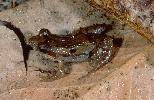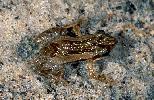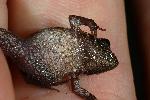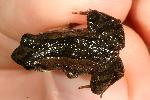Species profile—Crinia tinnula (wallum froglet)
Classification
Animalia (animals) → Amphibia (amphibians) → Myobatrachidae (Australian water frogs) → Crinia tinnula (wallum froglet)
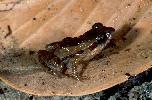
Go to Photo gallery
Sighting data
Species details
- Kingdom
- Animalia (animals)
- Class
- Amphibia (amphibians)
- Family
- Myobatrachidae (Australian water frogs)
- Scientific name
- Crinia tinnula Straughan & Main, 1966
- Common name
- wallum froglet
- Type reference
- Straughan, I and Main, A. 1966. Speciation and Polymorphism in the genus Crinia Tschudi (Anura : Leptodactylidae) in Queensland. Proceedings of the Royal Society of Queensland 78 (2) : 11-28.
- WildNet taxon ID
- 686
- Synonym(s)
- Ranidella tinnula
- Alternate name(s)
- tinkling froglet
- Nature Conservation Act 1992 (NCA) status
- Vulnerable
- Conservation significant
- Yes
- Confidential
- No
- Wetland status
- Wetland Indicator Species
- Endemicity
- Native
- Pest status
- Nil
- Map
- View Map
- Distribution
- The wallum froglet occurs in lowland coastal areas of subtropical eastern Australia from Littabella National Park, south-east Queensland, south to Kurnell, central New South Wales, including the sand islands off the Queensland coast (Fraser, Bribie, Moreton and North Stradbroke Islands). (Hines et al. 1999; Meyer et al., 2004).
- Distributional limits
- -24.6, 152.02
-28.18, 153.55 - Range derivation
- Range provided by taxon expert
- Species environment
- Aquatic & Terrestrial
- Habitat
- The wallum froglet can be found in acidic wetlands (pH 4.3-5.2) within Melaleuca swamps, sedgeland, wet or dry heathland and wallum/woodland areas in the sandy coastal lowlands (<100m asl) of south-east Queensland. Occasionally animals occur in adjacent forests with a heathy understorey, and are known to persist in disturbed wallum habitat such as 4WD-impacted sites, roadsides, quarry site, and exotic pine plantations and partly cleared areas. (Straughan & Main 1966; QPWS 2001; Meyer et al. 2006; McFarland 2007).
- Behaviour
- The wallum froglet is a nocturnal, terrestrial and cryptic species. Males call from secluded positions at the waters edge or from among sedge tussocks near the water level. During the day can be found sheltering down crayfish burrows, or under leaf litter and may be found well away from water. (Straughan & Main 1966; Cogger et al. 1983; Barker et al. 1995; McFarland 2007).
- Reproduction
- Breeding usually occurs in autumn or early winter, but has been recorded in all seasons following rain. During the season, males call from the base of sedges near water or from matted sedge clumps. Spawning typically occurs in shallow acidic waters (pH < 6.0) where 33-118 small eggs (1.1-1.2mm in diameter) are laid singly or in clumps attached to submerged vegetation. Tadpoles may take two-six months to develop into frogs, development slowing over winter. (Straughan & Main 1966; QPWS 2001; Anstis 2002; Meyer et al. 2006; McFarland 2007).
- Diet
- Adult wallum froglets eat several species of arthropods, and tadpoles have a diet of sediment and algae (Cogger et al. 1983; Anstis 2002).
- Human uses
- Nil
- Threatening processes
- Known:
1. Habitat loss & fragmentation due to agriculture, pine plantation establishment, urban & resort development. (Hines et al. 1999; Meyer et al. 2006).
Suspected:
1. Habitat alteration due to weed invasion, water extraction and inappropriate fire regime (Hines et al. 1999; Meyer et al. 2006).
2. Habitat degradation associated with urban development, agriculture and plantation forestry, e.g. altered hydrological regimes, increased nutrient and sediment loads and trampling (Ingram & McDonald 1993; Hines et al. 1999; Meyer et al. 2006).
3. Predation by the introduced mosquito fish (G. holbrooki) may threaten populations in low-lying areas subject to inundation (Meyer et al. 2006).
4. Chytrid fungus infection may also be a threat (Meyer et al. 2006).
5. Mosquito control may pose a threat to C. tinnula in urban and urban-fringe areas (Meyer et al. 2006).
6. May be susceptible to increased competition from other frog species, e.g. Crinia parinsignifera, that invade mainland wallum areas disturbed by roading, forestry and agriculture (Ingram & Corben 1975; Meyer et al 2006).
7. Pigs may pose a threat to C. tinnula in some areas (Meyer et al. 2006). - Status notes
- Listed as Vulnerable under Queensland legislation (Queensland Nature Conservation Act 1992) and New South Wales legislation (New South Wales Threatened Species Conservation Act 1995). Listed as Vulnerable by the IUCN (IUCN, 2004).
This species has experienced localised population extinctions due to habitat loss or fragmentation (Hines et al. 1999). - Notes
- Contributors: Keith R. McDonald 8/10/1999; David McFarland 26/10/2007; Danielle Hansen 16/01/2009; Wayne Martin 19/01/2009
- References
- Anstis, M. (2002). Tadpoles of South-eastern Australia. Reed New Holland, Sydney, NSW.
Barker, J., Grigg, G.C. & Tyler, M. J. (1995). A Field Guide to Australian Frogs. Surrey Beatty and Sons, Chipping Norton, NSW.
Cogger, H.G., Cameron, E.E. & Cogger, H.M. (1983). Zoological Catalogue of Australia, Vol. 1: Amphibia and Reptilia. AGPS, Canberra.
Ehmann, H. (1997). Wallum Froglet, Crinia tinnula. pp. 48-55 in H. Ehmann (ed) Threatened Frogs of New South Wales: Habitats, Status and Conservation. Frog and Tadpole Study Group of NSW Inc, Sydney South, Australia.
Hines, H., Mahony, M & McDonald K.R. (1999). An Assessment of Frog Declines in Wet Subtropical Australia. Pp 44-63 in A. Campbell (ed), Declines and Disappearances of Australian Frogs. Environment Australia, Canberra. 234 pp.
Ingram, G. J. and Corben, C. J. (1975). The frog fauna of North Stradbroke Island, with comments on the 'acid' frogs of the Wallum. Proceedings of the Royal Society of Queensland 86(9), 49-54.
Ingram, G.J. & McDonald, K.R. (1993). An update on the decline of Queensland's frogs. Pp 297-303 in D. Lunney & D. Ayers (eds), Herpetology in Australia. A diverse discipline. Royal Zoological Society of New South Wales, Mosman. 414pp.
McFarland, D.C. (2007). Taxon Profiles Version 2.0: Threatened And Priority Fauna Taxa In Queensland: Biology And Distribution. Queensland Environmental Protection Agency, Brisbane.
Meyer, E., Hero, J.M., Shoo, L. & Lewis, B. (2006). National recovery plan for the wallum sedgefrog and other wallum-dependent frog species. Report to Department of the Environment and Water Resources, Canberra. Queensland Parks and Wildlife Service, Brisbane.
Meyer, E.A., Hines, H.B, Clarke, J.M., Hodgon, J. & Gynther I. (2004). Occurrence of the wallum Froglet (Crinia tinnula) at Littabella National Park, South-eastern Queensland. Memoirs of the Queensland Museum 49, 691-692.
QPWS (2001). Crinia tinnula Wallum Froglet. Species Management Profile, Species Management Manual Vol. 2. Queensland Parks & Wildlife Service, Forest Management, Brisbane.
Straughan, I & Main, A. (1966). Speciation and polymorphism in the genus Crinia Tschudi (Anura : Leptodactylidae) in Queensland. Proceedings of the Royal Society of Queensland 78(2), 11-28. - Profile author
- Keith R. McDonald (19/01/2009)
Other resources
Data source
This profile data is sourced from the QLD Wildlife Data API using the Get species by ID function used under CC-By 4.0.
https://apps.des.qld.gov.au/species/?op=getspeciesbyid&taxonid=686.
This information is sourced from the WildNet database managed by the Queensland Department of Environment and Science.


